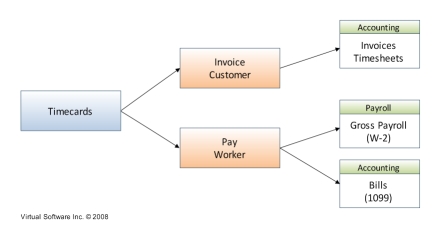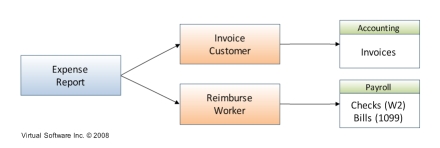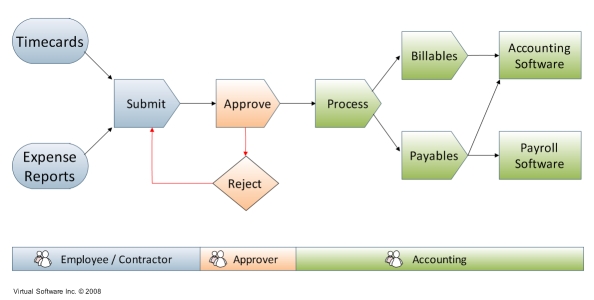Getting Started - Concepts Overview
The individual responsible for managing time and expense for your business is consider the accounting / administrative role within Virtual Time+Expense. This person or department is responsible for gathering information from employees and approvers, and using the data to and invoice clients and/or pay workers.
The basic building blocks of Virtual Time+Expense are timecards and expense reports. From this data, Virtual Time+Expense produces corresponding transactions within your accounting software including invoices, timesheets, W-2 Payroll for employees, payments to subcontractors, and expense reimbursements (depending on your companies needs). Transferring information from entry to accounting systems involves several steps and individuals whether using paper, spreadsheets or an automated web-based product like Virtual Time+Expense.
|
|
The movement of information through Virtual Time+Expense occurs in six main states: entry, approval, processing, billing, paying, and completed.
- Entry is typically performed by the employee or consultant, and is capped at the end of the cycle by submission for approval.
- Approval of time and expense can be performed by various types of users defined by your company, usually an external client manager or an internal project manager.
- Processing, in the context of Virtual Time+Expense, is two-fold. First, it is the accounting level of review and acceptance for time and expense that has been approved. Second, it prepares the information to be exported from Virtual Time+Expense into your accounting software. Once processed, your data is now ready to be billed (invoiced) and reimbursed (payroll/contractor payments/expense reimbursements) - in either order.
- Billing exports generated invoices into your accounting software.
- Paying exports generated gross payroll or reimbursements for W-2 employees to external payroll systems or your accounting software, and vendor payments to your accounting software.
- Completed is the final state once it has been both billed and paid. All historical time and expense in this state is still available in reports or by viewing previous exports.
Workflow describes the movement of information through Virtual Time+Expense. At any given time, each timecard and expense report is in one of the six states mentioned above. Virtual Time+Expense helps this flow of data from start to finish as quickly and efficiently as possible, and allowing you to know where anything is at any given time and the ability to act based on the information.
Here is a graphic representation of the Virtual Time+Expense workflow, color coded to who is typically responsible for each stage:
|
The states in the workflow can also be simplified as shown in figure 4 below (again color coded for who is responsible). We will use this flow diagram from now on within this guide to highlight where in the workflow you are currently reading about.
|
Each of the primary states in the workflow described above is represented by an "area" (or screen) in Virtual Time+Expense. To go to each area, you would click on the corresponding button in the products top area/button bar. The possible choices of areas that can be selected, are determined by who the person is and what roles they have been assigned.
Each area typically serves three purposes: present what data is waiting in that state, give you the tools to interact with the data, and allow you to move the data along to the next state in the workflow. A simple example is the "To Be Approved" area. When viewing this area, a manager is presented with a list of timecards and expense reports that are waiting for their approval. The tools in this area provide the ability to review the details of each timecard or expense report, reject if necessary, or forward it to another manager. If the data is acceptable, approving it from this area moves it to the next state and removes it from their list of pending approvals. The goal is to "clear" the list, at which point the work of the area is complete (until more data enters this state).
This example highlights a key aspect of Virtual Time+Expense: data waits at each state (like a "to-do" list) until the appropriate user selects and moves it to the next state. This means nothing can be lost in the system - you don't have search for data pending from one week then another, you are always shown all pending data at once. Its not about when or where, but rather if it is done or not done - and you want it all to be done (and the faster the better).
As illustrated by figure 3 above, timecards and expense reports are entered into the workflow by the employee/contractor, then submitted for approval.
 |
At the next state, the Approver rejects or approves it.
 |
During this process, the Accounting/Administrator oversees and ensures all data is submitted and approved in a timely manner, and moves it forward to be invoiced and paid. This concept is called Processing.
| Next step: |
 Overview of Processing Overview of Processing
|



